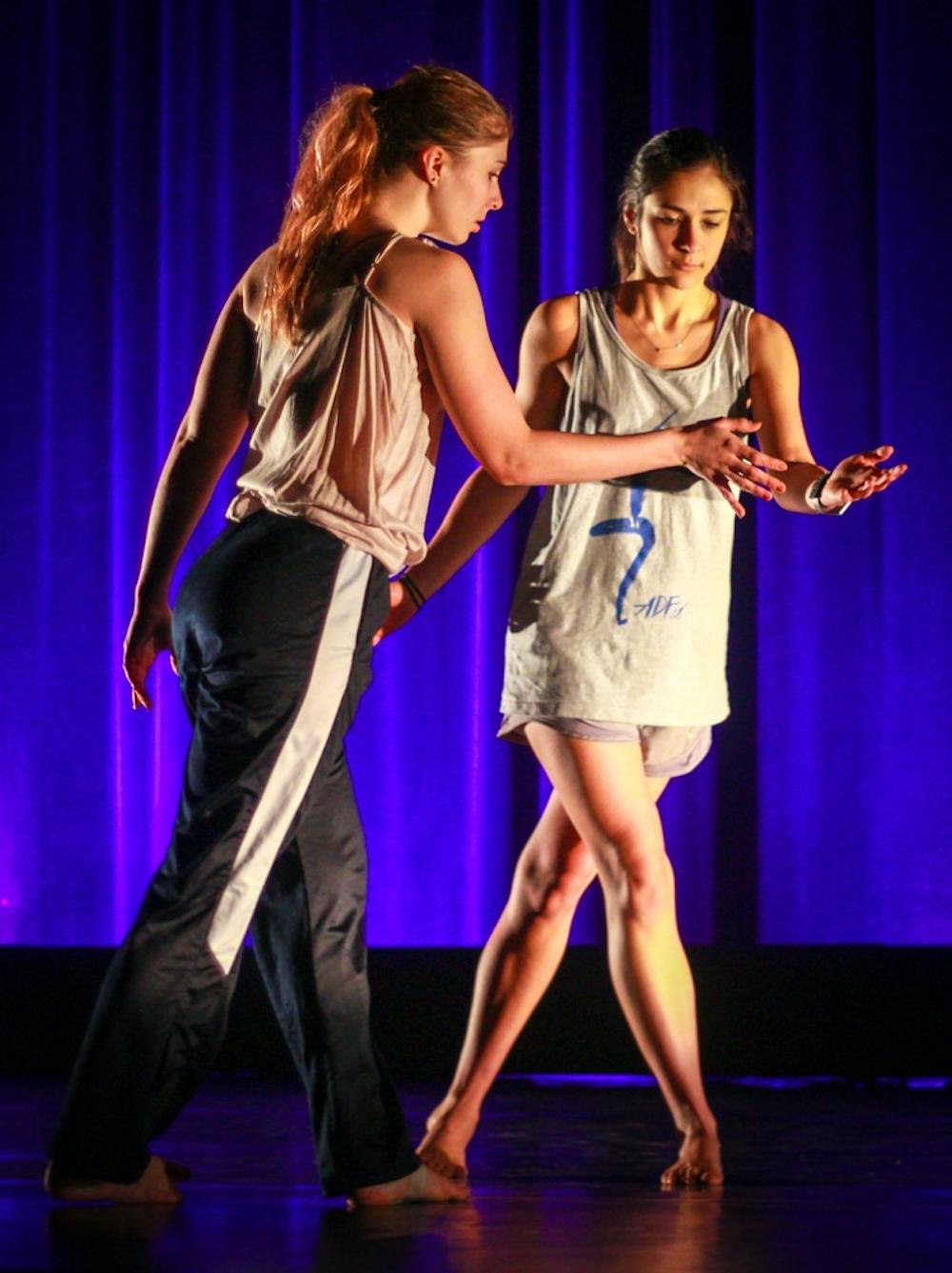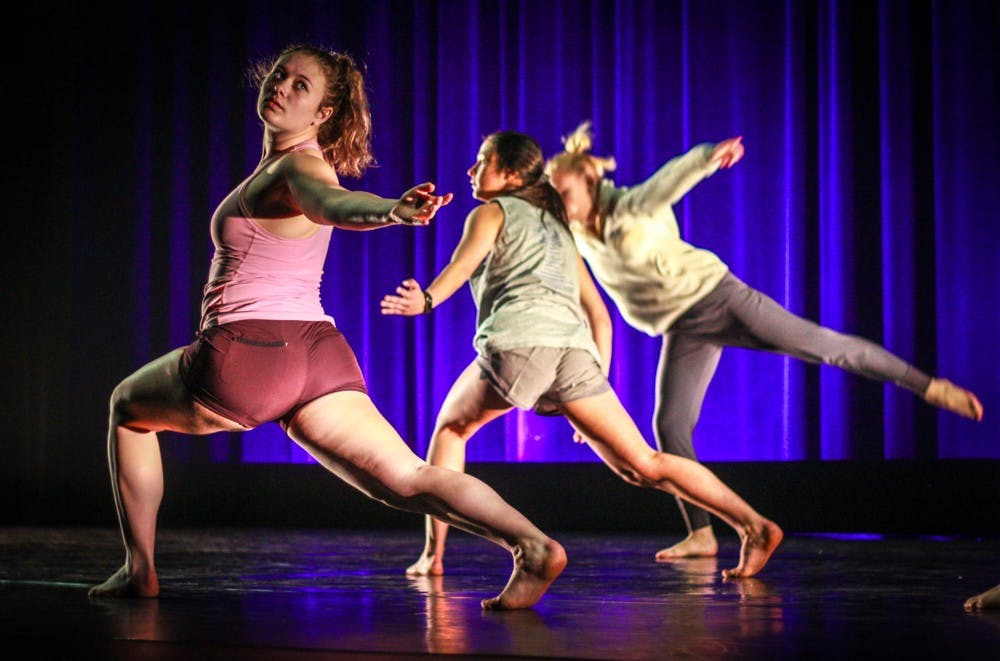The sound of waves crashing against the sand, backdrops of deep blue and purple and dancers dressed in all black.
These are some of the sights and sounds of Chroma, the dance department’s spring concert. The word “chroma” means the purity or intensity of color. While some pieces in the show have colorful costumes and lights, Renay Aumiller, assistant professor of dance and artistic director of Chroma, says others are colorful in a metaphorical way.
“I really wanted to bring a theme that was unifying for every piece and every choreographer, but I wanted a theme that could be abstract so that each choreographer didn’t feel limited,” Aumiller said. “I wanted them to feel that there is freedom in creating works that they wanted to create.”
Aumiller said while each piece is different, there is a theme linked through all of them — color.

“We have work that is very serious, but we also have really fun and quirky work,” Aumiller said. “There’s ballet that’s done to hip hop, there’s a dance that takes place in a 16-foot box and none of the dancers ever leave that.”
One piece called “Noir” features dancers in all black costumes and explores the absence of color. Sophomore dance major Jenna Kulacz said the movement in the piece gives it color.
“The intricacy of it is colorful because there are so many different shades of textures and sharp movement and soft movement,” Kulacz said. “And I think that’s what makes it wide on the color spectrum.”
Kulacz said color hues are an important part of the storytelling behind dance.
“In dance, colors can mean like bright purple explosive movement,” Kulacz said. “And then like a deep green can mean more like subdued and soft.”
Kulacz has been dancing since she was 8 years old. She said the two pieces she’s performing in Chroma are her favorite pieces she’s ever performed because they push her physically.
“One of them is extremely long, and the other one is also very physical with a lot of lifting,” Kulacz said. “It’s mostly about learning when to give it my all and go full out. I wanted to kind of find something else to make the performance special.”
To give her body a break, she uses other techniques like facial expressions to tell the story.
While Kulacz enjoys the physical challenge of dance, she thinks most people don’t understand the work that goes into putting on a show like Chroma.
“It requires a lot to be a dance major for sure,” Kulacz said. “You have to be full force in it, or it’s not going to be for you. But for someone like me, I love to work hard, so that’s never a problem for me.”
The week leading up to the performance is often full of long rehearsals. Chroma is the final bow for senior dance major Rachel Linsky. Even as a senior preparing for graduation, Linsky still feels the pressure of putting on a show.
“It’s definitely been a lot of work to be in rehearsal every day, 6 to 9 [p.m.] ,” Linsky said. “And to hold so much choreography in my brain, learning all these pieces, and now I think it’s just really exciting to finally like have all the pieces finished to feel
confident.”
Lifting each other up
Despite directing other projects, this is Aumiller’s first time artistically directing the spring dance concert. She said she’s enjoyed having the teamwork of the dancers, choreographers and behind-the-scenes workers.
“There’s this energy that has been created and cultivated by the faculty and students, and the wide array of experiences that the audience can have just by showing up is something that I think is really unique and exciting,” Aumiller said.
For Kulacz, dancing with a group is her favorite experience.
“You know they have your back, they’re there for you,” Kulacz said. “You come off the stage and know that you nailed it with your group, and there’s a feeling of family in that.”
The community Kulacz has found in her program helps her advance as a dancer.
“It’s easy to get comfortable and, you know, let them flip you around and let them like knock you upside down, which is literally my whole piece, I’m being lifted,” Kulacz said. “I have fallen in rehearsal, but it’s like I trust that they’ll be there.”
In between run-throughs, Kulacz and Aumiller sit outside McCrary Theatre to talk about the show’s progress. Kulacz said the mentorship found in faculty is encouraging.
“They seriously are the most supportive group of mentors for all of us,” Kulacz said. “They want us to succeed. They want us to thrive. And you know, it’s really, really special to be able to have these types of mentors in our life that really support us.”
Reaching an audience
As a dancer herself, Linsky said modern dance can be abstract and hard to understand. But she appreciates when non-dancers come to see the show.
“It’s always really exciting when my friends from outside of the department come and really enjoy a piece or really connect with something and take an interest in modern dance for that reason,” Linsky said.
Even if someone doesn’t have a background in dance, Kulacz thinks anyone can connect with the pieces in Chroma.
“It’s a form of entertainment, just like a Netflix show or going to see a movie,” Kulacz said. “If anything, it’s better because it’s in person, it’s live. Like the motions are real, the feelings are real, it’s raw.”
Kulacz hopes the audience leaves feeling both entertained and inspired. But for Aumiller, she wants the audience to think.
“I hope that they get to challenge their own curiosity in terms of looking and exploring how each choreographer may have approached Chroma,” Aumiller said.


